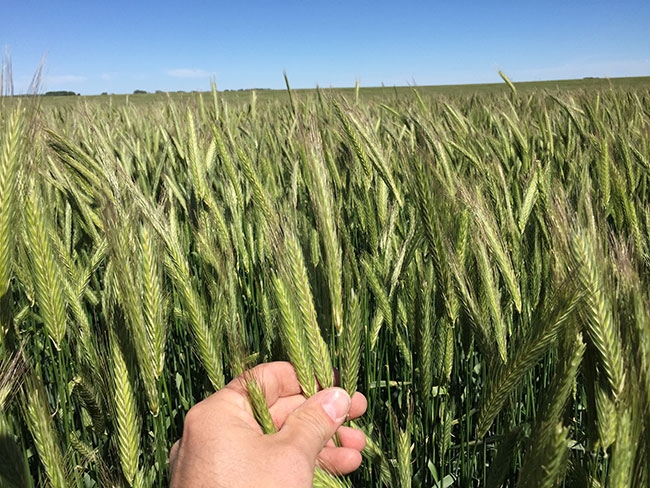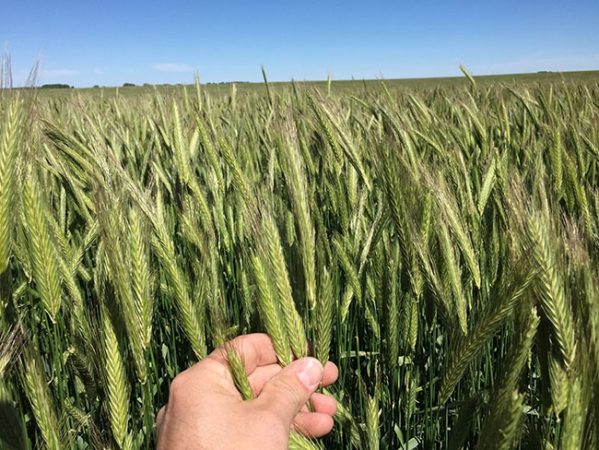
Features
Agronomy
Cereals
Why you should grow hybrid rye: yield advantages, pricing and market opportunities
Hybrid rye varieties have been grown on the Prairies for a couple of years now. They continue to live up to their initial promise, outshining open-pollinated (OP) rye varieties in key traits, and work is underway to help the hybrids capture a greater share of rye’s small marketplace.
June 19, 2017 By Carolyn King
 Hybrid rye varieties like Guttino (shown here) produce uniform stands with impressive yields. Hybrid rye varieties have been grown on the Prairies for a couple of years now.
Hybrid rye varieties like Guttino (shown here) produce uniform stands with impressive yields. Hybrid rye varieties have been grown on the Prairies for a couple of years now.Three hybrid ryes are currently available for western Canadian growers: Brasetto and Bono from FP Genetics and Guttino from SeedNet. All three hybrids are fall-seeded varieties developed by the German crop breeding company KWS, a global leader in rye breeding, and all three have many characteristics attractive to both growers and end-users.
A growing advantage
For growers, yield is the biggest advantage of the hybrids over OP ryes. “Regardless of the conditions they are grown under, we are getting 25 to 30 per cent higher yields for the hybrids, which is huge. A really good crop of open-pollinated rye is 70 bushels; we had lots of producers last year who were getting over 100 bushels of hybrid fall rye. Of course, that means better returns for the grower,” says Rod Merryweather, chief executive officer of FP Genetics.
“Also, the hybrids are four to five inches shorter than the OPs, sometimes even more than that, and they have much better lodging resistance. And hybrids mature much more uniformly, so direct combining is possible, which can save time and cost compared to swathing.”
David Hamblin of Red River Seeds in Morris, Man., has grown both Brasetto and Bono. “We’ve had some pretty phenomenal yields. The first year [in 2015], our yield was about 95 bushels per acre, even though we had about 25 per cent hail damage. And last year, our yield was 116.”
Hamblin, a shareholder in FP Genetics, had grown winter wheat but not fall rye before trying the hybrids. “We have been really impressed with the winter hardiness of the hybrids, especially compared to our winter wheat. The biggest thing we’ve noticed compared to winter wheat is the more uniform stand. We’ve put hybrid rye in some pretty rough conditions in the fall, some late seeding, and it still seems to come through the winter really well. Last fall, we actually seeded ours in October on soybean ground, and it looks fantastic right now [in early April].”
SeedNet member Greg Stamp of Stamp Seeds in Enchant, Alta., has been really struck by Guttino’s performance. “I don’t know if I fully realized the power of a hybrid crop until we started growing Guttino. We had some customers who did some demos and some trials comparing Guttino with some of the traditional rye varieties [in 2015]. In good conditions, Guttino yielded about 25 to 30 per cent better, but in dry conditions its yield advantage was even higher.
“The biggest difference was on dryland on light, sandy land where it was more drought-prone; they found about a 40 per cent yield difference between the traditional rye varieties and the hybrid. The stress hurt the traditional variety, but the hybrid seemed to power through.”
Like Hamblin, Stamp appreciates the great overwintering ability of the hybrids. “With Guttino being a nice, strong winter survivor compared to winter wheat, potentially you could plant it later than your winter wheat and still have equal or better results.” He adds, “It is amazing how fast it grows in the spring and heads out. It jumps ahead of winter wheat in the spring and it is such a vigorous plant.”
One main difference for growers is that hybrid rye seed is sold per unit, where a unit is one million viable seeds. “So depending on what my seed size and germination are, I’m filling more or less pounds per unit. For the customer, it’s a lot easier because you know what your plant stand will be,” Stamp explains. “It’s like the corn and soybean way of selling on a unit basis.”
The recommended seeding rate for the hybrids is 0.8 of a unit per acre, which results in an optimal population of 18 to 18.5 plants per square foot. That is a little lower than the recommended population for OP rye. The lower seeding rate allows the hybrids to tiller more, so they will be well established to overwinter successfully.
Another difference from the OPs is that, as hybrids, new seed will have to be purchased each year, as growers do for canola hybrids. Stamp says, “All these hybrid ryes are one-time use products. You wouldn’t want to use it again anyways because then you would get outcrossing and unpredictability in the plant in year 2.”
In an exciting advance, FP Genetics and KWS are developing hybrids that are less susceptible to ergot. Many cereals and grasses are hosts to this disease, but rye is especially prone to infection. Ergot is a concern because its overwintering fungal bodies, which develop in infected florets, contain alkaloids that are toxic to humans, livestock and poultry.
“KWS has a trait they call Pollen Plus that reduces susceptibility to ergot compared to OPs and to other hybrids by up to 50 per cent in the trials so far,” Merryweather explains. “We have interim registration on the first variety. We will be testing it in a field situation this year, comparing it to the others, to prove what it will do.”
If the results from these side-by-side comparison trials with growers in 2017 are as good as the results from small-plot studies over the previous three years, then FP Genetics will add this Pollen Plus variety to its hybrid line-up in 2018. Merryweather says, “I think it will add tremendous value because it may reduce the amount of rye that has to be cleaned to enter the food market and the feed market. And that would save growers money.”
Increasing acres
According to Merryweather, hybrid rye acres have increased dramatically on the Prairies. “Seeded the fall of 2015 and harvested in 2016 was really our first year and that was about 20,000 acres. This year we’ve got about 40,000 acres in Western Canada, so it’s doubled from one year to the next and we expect it to be substantially higher [this fall] – maybe another 50 per cent higher. But that will depend on the market and other factors. Last year, bad weather at harvest meant that a lot of growers who had planned to grow rye just couldn’t get it into the ground.”
Currently, prices for rye – like many other cereals – are relatively weak. Merryweather notes, “Last fall, rye was selling for $6 a bushel. This past fall it was $4. And now, even feed is selling for about $4.40 to $4.50 a bushel, so it is starting to come back. That is about the same as the price for wheat as feed.”
Also, Merryweather emphasizes that rye is a niche market crop. “Today there are about 300,000 to 350,000 acres of rye grown in Canada in any given year, with about 250,000 in Western Canada. We don’t expect those acres to increase [in the short term]. Ultimately the acres might increase, but that takes time.”
FP Genetics expects an increasing portion of the total rye acres to switch from OPs to hybrids in the next few years. Merryweather notes hybrids were seeded on about 10 to 15 per cent of the total rye acres planted in Western Canada last year, “so we’ve still got a long way that we can go.”
Nevertheless, it may also make economic sense for a grower to switch from winter wheat to hybrid rye. Merryweather says, “The difference in price between winter wheat and fall rye is small, if any, and hybrid rye yields about 15 per cent higher than winter wheat.”
Stamp is seeing a different trend in terms of who is growing Guttino. “Most of my customers are in southern Alberta, although I do have customers up near Edmonton and people in Saskatchewan who are trying the Guttino as well. A few of those customers are traditional rye growers, but quite a few are new rye growers,” he says.
“I’ve got some customers who are growing irrigated crops like dry beans and potatoes, and those aren’t your traditional rye growers by any stretch. They were trying Guttino because the market was reasonably good at the time – the market is a little soft right now for commercial rye – but they were trying it because it looks attractive to them and the yield potential is very high.”
Stamp adds, “I would say 130 to 150 bushels per acre would be the typical range for my customers on irrigation, and my top yielder was a customer who averaged 180 bushels an acre. But even if you get 100 bushels on dryland, that still is pretty good; it’s all relative to what else you can grow on that field.”

SeedNet member Greg Stamp has been really struck by Guttino’s performance, especially after seeing good yields in dry conditions.
Market opportunities
The hybrids offer various advantages for end-users, including the high-value food and beverage markets. “For milling, the hybrids have much higher falling numbers. In the last two or three years of testing, falling numbers for hybrid rye are always about 80 to 100 points higher than OPs grown in the same field. A higher falling number means a higher volume loaf, and the millers will probably be able to use more rye and less wheat to get that big loaf,” Merryweather says. “Another thing end-users like in the hybrids is that the grain is much more uniform, which makes it easier and more efficient to mill, distil or [process in other ways].”
FP Genetics is targeting these high-value markets. “Our sales to date have been concentrated in the eastern half of the Prairies. That is because we are focusing on supplying the food and beverage market. The biggest market for that is in the United States, and most of that is supplied through grain companies centred in
Minneapolis. So the closer you are to Minneapolis, the lower the freight costs to get the grain there and therefore the more competitive it is,” Merryweather explains.
He sees good potential to capture an increasing share of this market. “About 200,000 tonnes of rye is imported from Europe by the U.S. [for the distilling and milling markets]. If we can convert that back to Canadian rye – which it used to be – then that would grow our marketplace. They started importing from Europe because they couldn’t get a consistent supply of good quality rye from North America. If we can supply the quantity and quality, then we’ll ultimately get the business. We believe hybrid rye will enable us to do that.”
Merryweather also sees a big opportunity in the feed market. FP Genetics is working with KWS on feed studies, with KWS providing most of the funding. These studies include a major hog feeding study in Manitoba, which will be completed before planting next year.
He points out that rye is used extensively in Europe for livestock feed and many Prairie livestock producers already use rye in their feed. “However, we need to develop this market and doing these tests builds confidence because the local feed companies are controlling these studies and therefore they’ll make the recommendations. It all comes down to delivering the right nutrient package at the lowest price because that is how the cattle and hog guys make their money. So we expect that market to grow considerably.”
Like Merryweather, Stamp sees a lot of potential for hybrid rye in the feed market. “The economics would have to make sense, but I can see the feed market really being where, if the farmer isn’t going to get that milling price or that distillery price, they are going to be able to move volume and [it will] still make sense for them to grow a hybrid rye even at the feed market price. Right now the feed market price is kind of low, but it will not always be that way.”
Silage is another option for some growers. Stamp says, “I have a lot of customers in the Picture Butte area [of Alberta] with feedlots, and some dairy as well, who are using the hybrid rye for silage and getting big tonnes. Some of the feedlot people are telling me the net returns are comparable to corn, because the costs to grow rye are lower. It can be grown on more marginal land than silage corn. So the tonnage and nutrient value per acre with hybrid rye is netting comparable to corn. [Because rye silage is cut earlier than corn silage], it spreads out the workload for their people and machines; silage choppers are not cheap, so the more acres they can put through one machine, the better, and rye diversifies their risk from just corn silage.”
For new rye growers who are looking into possible markets, Merryweather has some suggestions. “Our grain partners are a good place to start. Scoular and Providence Grain Solutions are contracting most of our production. Their objective is predominantly to supply food and beverage markets in North America, which is the highest price market.” As well, there may be local rye buyers like small millers or distillers, craft breweries, cattle and swine producers and ethanol plants. However, he doesn’t think these smaller markets have necessarily developed a preference for hybrids yet.
“We’re not saying the hybrids will change the price a farmer will get for rye, but he’s got a lot more to sell. Hybrid rye is just too small a part of the marketplace to have that influence, although it’s more likely that a hybrid will be selected for the high-price markets like milling because the hybrids are usually better quality with a high falling number,” Merryweather notes.
He adds, “I believe most of the grain bought by end-users last year wasn’t pure hybrids; it was blended with other rye. But that’s just until we build enough volume that the grain companies will keep it separate, which they are starting to do.”
“The market is still developing. A lot of the buyers want to see a little more of a track record as the years go by, to make sure the quality is there year-to-year. As we continue to prove that, I think the markets will come along,” Hamblin says.
“Rye is obviously a small market compared to a lot of our major crops. And we’re vastly increasing the yields over traditional rye yields, and it’s going on acres that never were traditionally growing rye. So I think we just have to be a little patient with allowing the market to come along with hybrid rye and make sure that a lot of the processors, especially in the States, are using Canadian rye instead of rye from other parts of the world and hopefully we don’t get the markets oversupplied.”
